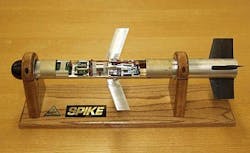Navy issues urgent request for thermal batteries to power Spike missile variant that launches from UAVs
RIDGECREST, Calif., 25 March 2012. U.S. Navy missile designers are sending out an urgent request to industry for weapons-grade thermal batteries to power a new generation of the Spike missile that naval designers are adapting to unmanned aerial vehicles (UAVs) such as the General Atomics MQ-9 Reaper and the Northrop Grumman MQ-8 Fire Scout unmanned helicopter.
Officials of the Naval Air Warfare Center (NAWC) Weapons Division at China Lake, Calif., near Ridgecrest issued an urgent request for quote (solicitation N68936-12-T-0114) last week for quotations on thermal batteries for a new version of the Spike missile.
NAWC experts at China Lake reportedly are developing a version of the Spike missile that is two feet long and weighs about five pounds to launch from small UAVs in the global war on terror. Primary applications of the new Spike version are to destroy vehicles and other small high-priority targets.
| Related stories -- EADS and Saft America launch thermal battery company devoted to military market -- Navy funds battery research -- U.S. Army contracts Electro Energy to develop thermal batteries. |
The new versions of the Spike missile reportedly are much smaller than the 100-pound Hellfire missile that typically arms the Reaper UAV. Reapers can carry two or three Hellfire missiles today, but reportedly could carry as many as 12 of the new five-pound Spike missiles.
The new light Spike missile also could arm smaller fixed-wing and rotorcraft UAVs, which today remain unarmed because of their small sizes. The latest extended-range version of the Spike missile are designed to destroy targets as far away as 15 miles.
Thermal batteries are molten-salt or liquid-sodium high-temperature batteries for applications such as missiles and other weapon systems where high energy density and high power density are necessary. These batteries typically are inactive in storage, and are activated for use typically with a pyrotechnical heat source that heats the cell to its operating range of 400 to 500 degrees Celsius.
At normal ambient temperatures the thermal battery's electrolyte remains solid and inactive, but when heated to its operating temperature, the battery's electrolyte turns to liquid and becomes active.
Experts say thermal batteries can be stored safely and with no degradation for as long as 50 years. Thermal batteries are the primary power source for missiles such as the AIM-9 Sidewinder, MIM-104 Patriot, BGM-71 TOW, and BGM-109 Tomahawk.
The thermal battery solicitation for the new Spike missiles, issued by the The Emergent Weapons System Division of the NAWC Weapons and Energetics Department, is open to "all responsible sources," and is for rapid development of the new Spike variant, which is scheduled for live-fire demonstration beginning in March 2013.
Once the Spike's thermal battery is designed and accepted, Navy officials say they may order as many as 1,200 of the batteries every year.
Companies interested in submitting bids must respond to NAWC China Lake no later than 30 March -- which is this coming Friday. Sends bids to the NAWC's Jennie Norris by e-mail at [email protected], by fax at 760-939-1937, or by post to NAWCWPNS, Code 220000D, Attn: Jennie Norris, 429 E. Bowen Road, Mail Stop 4015, China Lake, Calif. 93555.
For questions or concerns contact the NAWC's Jennie Norris by phone at 760-939-9457, by fax at 760-939-1937, or by e-mail at [email protected]; or Faith La Gore by phone at 760-939-0852, by fax at 760-939-3095, or by e-mail at [email protected].
More information is online at http://www.fbodaily.com/archive/2012/03-March/22-Mar-2012/FBO-02700667.htm.
Follow Military & Aerospace Electronics and Avionics Intelligence news updates on Twitter

John Keller | Editor
John Keller is editor-in-chief of Military & Aerospace Electronics magazine, which provides extensive coverage and analysis of enabling electronic and optoelectronic technologies in military, space, and commercial aviation applications. A member of the Military & Aerospace Electronics staff since the magazine's founding in 1989, Mr. Keller took over as chief editor in 1995.



